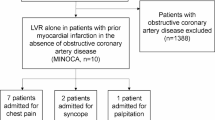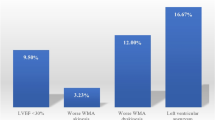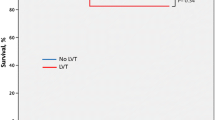Abstract
Left ventricular apical aneurysm (LVAA) is a serious complication of acute anterior myocardial infarction (MI). The purpose of our study was to investigate the clinical features of LVAA in the primary PCI era. A total of 161 acute anterior MI patients who had primary PCI and had an echocardiogram on chronic phase were included. The development of LVAA was reviewed on chronic phase. Univariate and multivariate logistic regression analyses were performed to identify the predictors of LVAA. Primary stenting was performed in 160 patients (99.4 %). Procedural success was obtained in all patients with a final TIMI flow grade 3 obtained in 142 patients (88.2 %). LVAA developed in the chronic phase in 29 patients (18.0 %). Multivariate logistic regression analysis revealed that peak CK (500 mU/ml increase; OR 1.24, 95 % CI 1.09–1.41, p = 0.001), heart rate at discharge (5/min increase; OR 1.39, 95 % CI 1.03–1.87, p = 0.03), final TIMI flow grade ≤2 (vs. TIMI 3; OR 6.95, 95 % CI 1.70–28.36, p = 0.01) and final myocardial brush grade (MBG) ≤2 (vs. MBG 3; OR 4.33, 95 % CI 1.06–17.66, p = 0.04) were significantly associated with the development of LVAA. The initial TIMI flow grade or the grade of collateral flow was not associated with LVAA. In conclusion, peak CK, heart rate, and final TIMI flow grade or final MBG ≤2 were significantly associated with the development of LVAA. Achieving a TIMI flow grade 3 by primary PCI may be important for preventing LVAA.

Similar content being viewed by others
References
Letac B, Leroux G, Cribier A, Soyer R (1978) Large ventricular aneurysms occurring after myocardial infarction. Br Heart J 40:516–522
Shen WF, Tribouilloy C, Mirode A, Dufosse H, Lesbre JP (1992) Left ventricular aneurysm and prognosis in patients with first acute transmural anterior myocardial infarction and isolated left anterior descending artery disease. Eur Heart J 13:39–44
Keeley EC, Hillis LD (1996) Left ventricular mural thrombus after acute myocardial infarction. Clin Cardiol 19:83–86
Nixon JV (1983) Left ventricular mural thrombus. Arch Intern Med 143:1567–1571
Kulakowski P, Dluzniewski M, Budaj A, Ceremuzynski L (1991) Relationship between signal-averaged electrocardiography and dangerous ventricular arrhythmias in patients with left ventricular aneurysm after myocardial infarction. Eur Heart J 12:1170–1175
Hansen ML, Sorensen R, Clausen MT, Fog-Petersen ML, Raunso J, Gadsboll N, Gislason GH, Folke F, Andersen SS, Schramm TK, Abildstrom SZ, Poulsen HE, Kober L, Torp-Pedersen C (2010) Risk of bleeding with single, dual, or triple therapy with warfarin, aspirin, and clopidogrel in patients with atrial fibrillation. Arch Intern Med 170:1433–1441
Forman MB, Collins HW, Kopelman HA, Vaughn WK, Perry JM, Virmani R, Friesinger GC (1986) Determinants of left ventricular aneurysm formation after anterior myocardial infarction: a clinical and angiographic study. J Am Coll Cardiol 8:1256–1262
Tikiz H, Atak R, Balbay Y, Genc Y, Kutuk E (2002) Left ventricular aneurysm formation after anterior myocardial infarction: clinical and angiographic determinants in 809 patients. Int J Cardiol 82:7-14; discussion 14-16
Aversano T, Aversano LT, Passamani E, Knatterud GL, Terrin ML, Williams DO, Forman SA (2002) Thrombolytic therapy vs primary percutaneous coronary intervention for myocardial infarction in patients presenting to hospitals without on-site cardiac surgery: a randomized controlled trial. JAMA 287:1943–1951
Mehta RH, Sadiq I, Goldberg RJ, Gore JM, Avezum A, Spencer F, Kline-Rogers E, Allegrone J, Pieper K, Fox KA, Eagle KA (2004) Effectiveness of primary percutaneous coronary intervention compared with that of thrombolytic therapy in elderly patients with acute myocardial infarction. Am Heart J 147:253–259
Berrocal DH, Cohen MG, Spinetta AD, Ben MG, Rojas Matas CA, Gabay JM, Magni JM, Nogareda G, Oberti P, Von Schulz C, Doval H, Bazzino OO, Cagide A, Oliveri R, Grinfeld LR (2003) Early reperfusion and late clinical outcomes in patients presenting with acute myocardial infarction randomly assigned to primary percutaneous coronary intervention or streptokinase. Am Heart J 146:E22
Lazzeri C, Valente S, Chiostri M, Attana P, Picariello C, Gensini GF (2012) Impact of hypertension on short- and long-term prognoses in patients with ST elevation myocardial infarction and without previously known diabetes. Heart Vessels 27:370–376
Chen Y, Wang C, Yang X, Wang L, Sun Z, Liu H, Chen L (2012) Independent no-reflow predictors in female patients with ST-elevation acute myocardial infarction treated with primary percutaneous coronary intervention. Heart Vessels 27:243–249
Heras M, Sanz G, Betriu A, Mont L, de Flores T, Navarro-Lopez F (1990) Does left ventricular aneurysm influence survival after acute myocardial infarction? Eur Heart J 11:441–446
Aguirre FV, Younis LT, Chaitman BR, Ross AM, McMahon RP, Kern MJ, Berger PB, Sopko G, Rogers WJ, Shaw L, Knatterud G, Braunwald E (1995) Early and 1-year clinical outcome of patients’ evolving non-Q-wave versus Q-wave myocardial infarction after thrombolysis. Results from The TIMI II Study. Circulation 91:2541–2548
Rentrop KP, Cohen M, Blanke H, Phillips RA (1985) Changes in collateral channel filling immediately after controlled coronary artery occlusion by an angioplasty balloon in human subjects. J Am Coll Cardiol 5:587–592
Ambrose JA, Almeida OD, Sharma SK, Dangas G, Ratner DE (1997) Angiographic evolution of intracoronary thrombus and dissection following percutaneous transluminal coronary angioplasty (the Thrombolysis and Angioplasty in Unstable Angina [TAUSA] trial). Am J Cardiol 79:559–563
van ‘t Hof AW, Liem A, Suryapranata H, Hoorntje JC, de Boer MJ, Zijlstra F (1998) Angiographic assessment of myocardial reperfusion in patients treated with primary angioplasty for acute myocardial infarction: myocardial blush grade. Zwolle Myocardial Infarction Study Group. Circulation 97:2302–2306
Lenderink T, Simoons ML, Van Es GA, Van de Werf F, Verstraete M, Arnold AE (1995) Benefit of thrombolytic therapy is sustained throughout five years and is related to TIMI perfusion grade 3 but not grade 2 flow at discharge. The European Cooperative Study Group. Circulation 92:1110–1116
Lincoff AM, Topol EJ, Califf RM, Sigmon KN, Lee KL, Ohman EM, Rosenschein U, Ellis SG (1995) Significance of a coronary artery with thrombolysis in myocardial infarction grade 2 flow “patency” (outcome in the thrombolysis and angioplasty in myocardial infarction trials). Thrombolysis and Angioplasty in Myocardial Infarction Study Group. Am J Cardiol 75:871–876
Anderson JL, Karagounis LA, Becker LC, Sorensen SG, Menlove RL (1993) TIMI perfusion grade 3 but not grade 2 results in improved outcome after thrombolysis for myocardial infarction. Ventriculographic, enzymatic, and electrocardiographic evidence from the TEAM-3 Study. Circulation 87:1829–1839
Stone GW, Peterson MA, Lansky AJ, Dangas G, Mehran R, Leon MB (2002) Impact of normalized myocardial perfusion after successful angioplasty in acute myocardial infarction. J Am Coll Cardiol 39:591–597
Cohen M (2009) Antiplatelet therapy in percutaneous coronary intervention: a critical review of the 2007 AHA/ACC/SCAI guidelines and beyond. Catheter Cardiovasc Interv 74:579–597
Chen YL, Chang CL, Chen HC, Sun CK, Yeh KH, Tsai TH, Chen CJ, Chen SM, Yang CH, Hang CL, Wu CJ, Yip HK (2011) Major adverse upper gastrointestinal events in patients with ST-segment elevation myocardial infarction undergoing primary coronary intervention and dual antiplatelet therapy. Am J Cardiol 108:1704–1709
Bussmann WD, Passek D, Seidel W, Kaltenbach M (1981) Reduction of CK and CK-MB indexes of infarct size by intravenous nitroglycerin. Circulation 63:615–622
Hackel DB, Reimer KA, Ideker RE, Mikat EM, Hartwell TD, Parker CB, Braunwald EB, Buja M, Gold HK, Jaffe AS, Muller JE, Raabe DS, Rude RE, Sobel BE, Stone PH, Roberts R (1984) Comparison of enzymatic and anatomic estimates of myocardial infarct size in man. Circulation 70:824–835
Parodi G, Bellandi B, Valenti R, Memisha G, Giuliani G, Velluzzi S, Migliorini A, Carrabba N, Antoniucci D (2010) Heart rate as an independent prognostic risk factor in patients with acute myocardial infarction undergoing primary percutaneous coronary intervention. Atherosclerosis 211:255–259
Antoni ML, Boden H, Delgado V, Boersma E, Fox K, Schalij MJ, Bax JJ (2012) Relationship between discharge heart rate and mortality in patients after acute myocardial infarction treated with primary percutaneous coronary intervention. Eur Heart J 33:96–102
Brener SJ, Cristea E, Lansky AJ, Fahy M, Mehran R, Stone GW (2012) Operator versus core laboratory assessment of angiographic reperfusion markers in patients undergoing primary percutaneous coronary intervention for ST-segment-elevation myocardial infarction. Circ Cardiovasc Interv 5:563–569
Conflict of interest
None.
Author information
Authors and Affiliations
Corresponding author
Rights and permissions
About this article
Cite this article
Mori, M., Sakakura, K., Wada, H. et al. Left ventricular apical aneurysm following primary percutaneous coronary intervention. Heart Vessels 28, 677–683 (2013). https://doi.org/10.1007/s00380-012-0301-2
Received:
Accepted:
Published:
Issue Date:
DOI: https://doi.org/10.1007/s00380-012-0301-2




